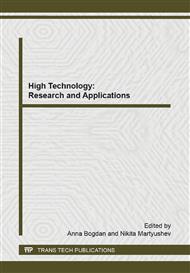[1]
Yuryev A.B., Gromov V.E., Kozlov E.V., The formation and evolution of structural-phase state and properties of steels in forming the modern technologies, J. Nauka. (2003) 347 -351.
Google Scholar
[2]
Apasov A. M, Valuev D.V., Danilov V.I., On the possible causes of marriage large pieces of low-carbon manganese steel rodistoy to PO Yurmash, J. Proceedings of the TPU. 3 (2007) 90-92.
Google Scholar
[3]
Koneva N.A., Kozlov E.V. J. Trans. Physics. № 8 (1982) 3-14.
Google Scholar
[4]
Sorokin V.G., Gervase M.A., Paleev V.S. Steels and Alloys. Database of. J. Intermet Engineering. (2001) 608-612.
Google Scholar
[5]
. Potekaev A. I Structural and phase states of metallic systems. J. NTL (2004) 356-360.
Google Scholar
[6]
Metallurgy and heat treatment of steel. Handbook. Vol. II. Heat treatment of metal (Eds. ) Bernstein M.L., Rahshtadt A.G. Metallurgy, Moscow 1983, 368 p.
Google Scholar
[7]
Metallurgy and heat treatment of steel. Handbook. Vol. III. Heat treatment of metal (Eds. ) Bernstein M.L., Rahshtadt A.G. Metallurgy, Moscow 1983, 216.
Google Scholar
[8]
Psakhie S. G., Ovcharenko V.E. , Yu B., Shilko E.V., Astafurov S.V., Ivanov Y.F., Beliy A.V., Mokhovikov A.A., Influence of Features of Interphase Boundaries on Mechanical Properties and Fracture Pattern in Metal–Ceramic Composites, J. Journal of Materials Science and Technology. 29, (2013).
DOI: 10.1016/j.jmst.2013.08.002
Google Scholar
[9]
Zhulev S.I., Zyuba N.A. Production and quality problems forging ingot. VSTU, Volgograd, (2003).
Google Scholar
[10]
Lasukov A.A. , Mokhovikov A.A. Influence of Modified Layer of Tool on Stress – Strain State of Cutting Wedge, 7th International Forum on Strategic Technology (IFOST - 2012) Tomsk, 2 (2012) 139-142.
DOI: 10.1109/ifost.2012.6357720
Google Scholar
[11]
Lychagin D.V., Gershteyn G., Fedoseev S.N., Alferova E.A. Distribution of alloying elements in γ- and γ'-phases of heat-resistant alloy PWA 1480, J. Applied Mechanics and Materials. 379 (2013) 149-153.
DOI: 10.4028/www.scientific.net/amm.379.149
Google Scholar
[12]
Shtremel M.N. Problems of metallurgical quality of the steel (non-metallic inclusions), J. Mitomo, 8 (1980) 2-6.
Google Scholar


